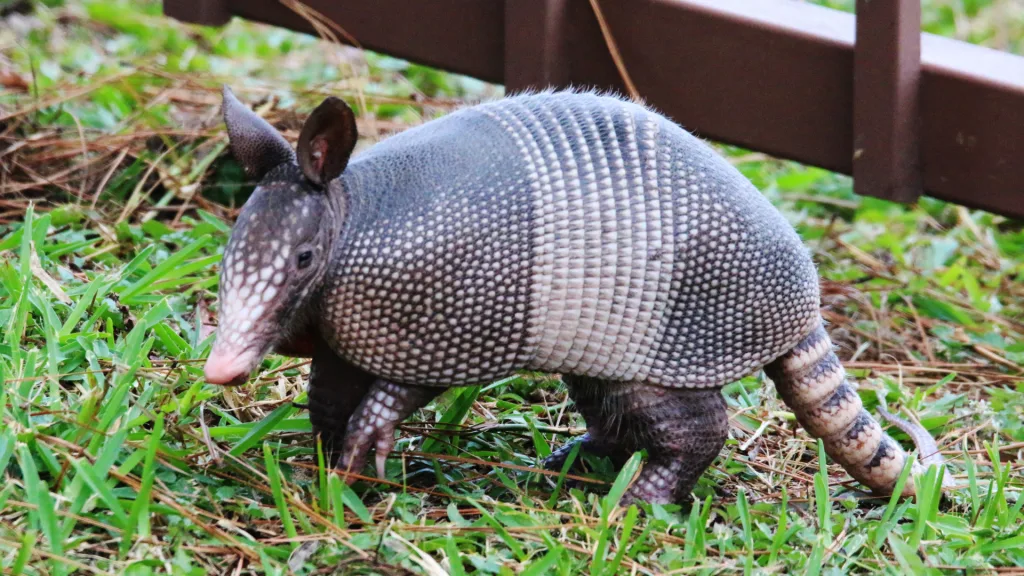Armadillos seem like something out of a pre-historic time. Odd-looking, with armored plates covering head to toe, they’re a quirky addition to the animal kingdom.
Maybe you’ve heard recent rumors that these critters can transmit leprosy to humans. In America, this disease isn’t a common ailment, but it’s got a long history.
That snuffling critter in your back garden might spread a plague of biblical proportions. Find out if it’s truth or fiction.
Let’s dig in!
What Are Armadillos?
Armadillos look like something from pre-historic times because they are. Directly descended from creatures the size of a Volkswagen Beetle, modern ‘dillos are bizarre. Originating in South America over 50 million years ago, they’re known for their unique defense. They look like tiny animal knights because they’re covered in bony, interlocking plates.
Powerful claws make them world-class diggers. Though they look reptilian, they’re mammals, and some species may have up to 15 pups at a time. Their dens are perfect homes for these shy creatures. Once abandoned, they make homes for other animals too.
Only one species, the three-banded armadillo, rolls into a ball for protection.
Where Do These Shelled Creatures Live?
In the US, they live in the south and mid-west but range down into South America. Millions of years ago, Central America emerged from the sea, and they headed north. They don’t tolerate cold climates, so they’re usually not seen north of Oklahoma.
You’ll commonly see them shuffling around in the underbrush of forests, feeding on insects and plants. They also live in desert regions and burrow to hide from predators. In Texas, they’re recognized as the “small state mammal.”

Do Armadillos Carry Leprosy?
Armadillos are known for having low body temperatures; that’s why they thrive in warmer climates. But that also contributes to one of the modern mysteries of science. In some areas, over 20% of the population carries leprosy.
The disease transmits from human to human in most regions of the world. But in South and Central America, the humble armadillo harbors a dangerous illness.
This pathogen spreads through contact and is rare in the modern world. In the few cases that occur in the United States, a different culprit might be responsible.
What Is Leprosy?
Leprosy, also known as Hansen’s disease, affects the skin and nerves in human populations. Since ancient times, communities have cast people suffering from the ailment out of society to protect others. They gathered in leper colonies away from outsiders.
Because sufferers lose sensation in their skin, injuries, and infections are common. Caused by a bacterial infection, a cure wasn’t available until 1916. African American scientist Alice Ball discovered that injecting chaulmoogra oil cured the disease.
Pro Tip: Looking to experience cool animals without actually encountering the wildlife? Check out these 7 Places to See Dinosaur Fossils and Footprints in the USA.

How to Avoid Contracting Leprosy from Armadillos
Animal-to-human transmission of leprosy is possible, and you don’t want to catch it. We’ve gathered some tips to avoid getting sick from Armadillos.
Avoid Contact
This is a common-sense answer that everyone should follow. Wild animals aren’t tame creatures, no matter how adorable they look. Aside from the possibility of disease, these armored critters have other defenses that make it a good idea to avoid them.
Sharp claws and sharp shells give them a leg up on the competition. You might think they’re harmless, but they can cut you if you grab them. Even dead on the side of the road, they can still transmit the pathogen. If you need to remove a stinker, use a shovel. Then, clean the shovel!
Wash Your Hands
Handling animals is only a good idea if you have proper training. Occasionally you might need to move a rogue animal. If you need to move an armadillo, follow CDC hand-washing protocols.
Experts recommend washing up to the elbows for a full twenty seconds with soap and water. Tell your doctor if you start to feel ill after handling one of these critters. They can recommend testing to see if you’ve contracted the bacteria.

Cook Meat Thoroughly
Yes, people eat armadillo meat. It’s a lean source of protein and readily available in some areas. People who’ve consumed the critters say it tastes like pork. We’ll take their word on that.
Game meats usually must be cooked thoroughly because they may contain parasites. Armadillo is no exception. It’s unlikely that you’ll contract Hansen’s from eating the meat but cook it all the way.
Stew, chili, and barbecue recipes are out there if bushmeat is your thing. Purchase the meat from a reputable source if you can. Hunters, make sure you wash your hands after handling the creatures.
Wear Protective Equipment
Folks who work with these armored animals should always wear personal protective equipment. A mask, goggles, and gloves go a long way toward reducing the spread of pathogens.
But it’s not just for handling the creatures. If you live in an area where armadillos are present, you should protect yourself when gardening. Even their poo harbors the bacteria that causes leprosy.
Gardening gloves are a good start, but you should still wash your hands afterward.
Seek Medical Attention
Injuries around wildlife happen. It’s a fact of life. If armadillos are involved, you need to take steps to protect yourself. Wash cuts or abrasions with anti-bacterial soap immediately. Protect the areas until you can seek medical help.
Severe injuries are a distinct possibility with these animals. In every case, talk to your doctor about your exposure. If testing or further treatment is necessary, they need all the facts.
Pro Tip: Want to learn more about unique creatures? We did some investigating to uncover Are Jackalopes Real Animals?
Protect Yourself from Armadillos and Leprosy
If history taught us anything about the spread of disease, prevention is better than treatment. Make sure you avoid these adorable little mammals when you see them. They’re mostly beneficial, but don’t touch them if you can help it. Contact won’t kill you, but wash up after you do.
Like most wildlife, appreciate these ancient critters from afar. They’ll thank you for it.
We’ll Help You Find the Best Free Camping in the USA
You should give it a try!
As a matter of fact, these free campsites are yours to enjoy. Every time you pay federal taxes, you’re contributing to these lands.
Become a FREE CAMPING INSIDER and join the 100,000 campers who love to score the best site!
We’ll send you the 50 Best Free Campsites in the USA (one per state). Access the list by submitting your email below: